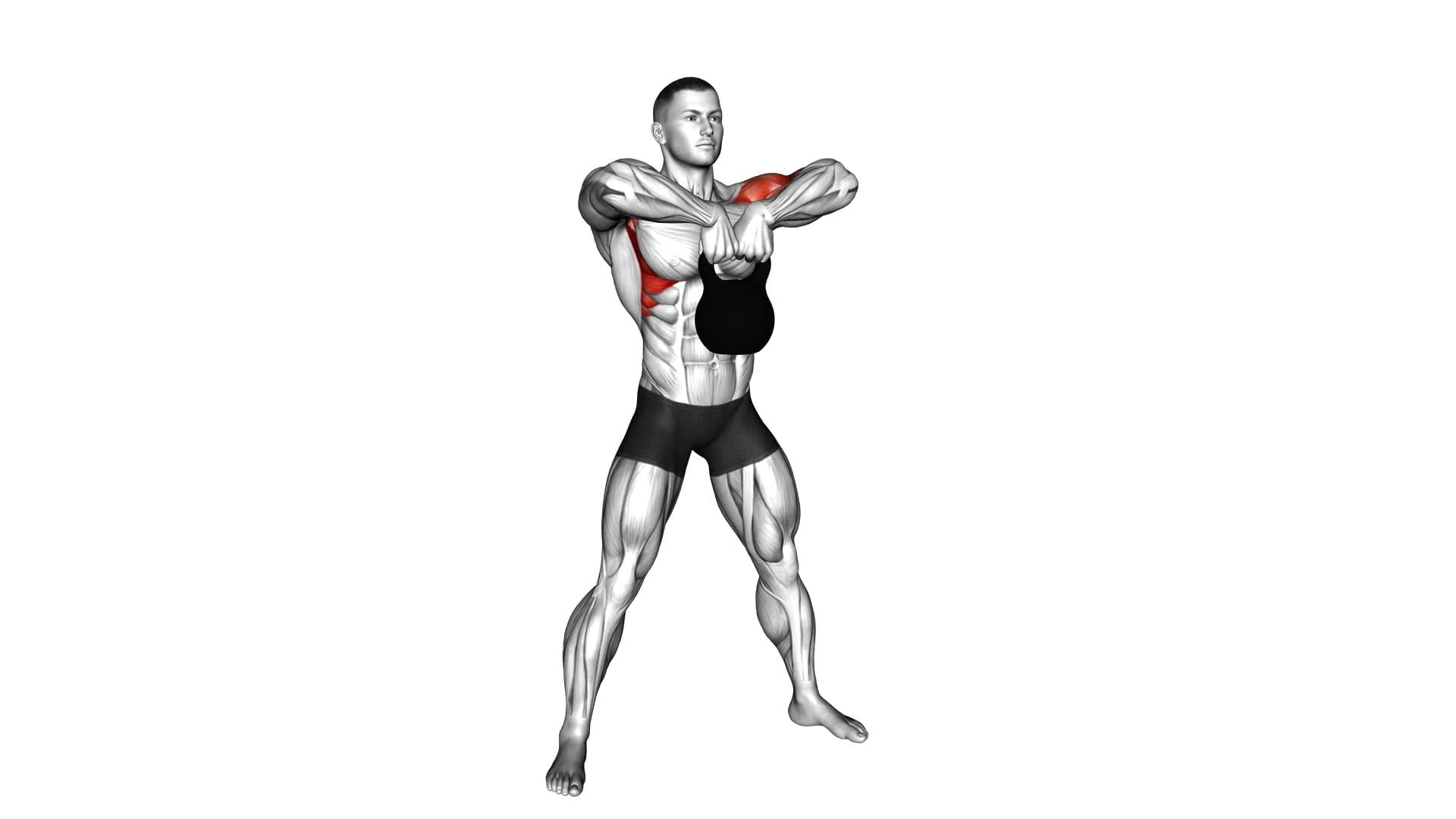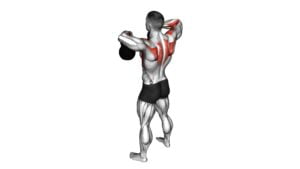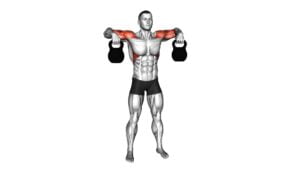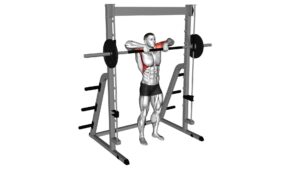Kettlebell Upright Row – Video Exercise Guide & Tips

Are you looking for an effective exercise to target your shoulder and upper back muscles? Look no further than the kettlebell upright row!
Watch This Exercise Video
In this video exercise guide, you'll learn the proper form and technique, as well as common mistakes to avoid.
With variations and progressions to challenge yourself, you can easily incorporate the kettlebell upright row into your workout routine.
Get ready to strengthen and tone those muscles with this powerful exercise.
Key Takeaways
- The Kettlebell Upright Row targets multiple muscle groups simultaneously, including the shoulders, upper back, and biceps.
- Using kettlebells for this exercise saves time and increases efficiency in workouts.
- Safety considerations include choosing an appropriate weight, maintaining proper form and technique, and regularly checking equipment for wear or damage.
- Alternatives to traditional equipment for the Kettlebell Upright Row include dumbbells, resistance bands, and barbells, providing options if kettlebells are not available.
Benefits of the Kettlebell Upright Row
One of the benefits of the Kettlebell Upright Row is that it targets multiple muscle groups at once, giving you a more efficient workout. This exercise primarily works your shoulders, upper back, and biceps. By engaging these muscles simultaneously, you can save time and get more out of your training session.
Another key benefit of the Kettlebell Upright Row is its versatility. There are several variations and progressions that you can incorporate to challenge yourself and keep your workouts interesting. For instance, you can increase the weight of the kettlebell to add more resistance and intensity. You can also perform the exercise with a single arm, which will engage your core and help improve stability.
Furthermore, the Kettlebell Upright Row is a compound exercise, meaning it involves multiple joints and muscle groups. This makes it a highly functional movement that mimics real-life activities. By incorporating this exercise into your routine, you can improve your overall strength, posture, and coordination.
Equipment Needed for the Exercise
To perform the kettlebell upright row exercise, there are a few essential pieces of equipment you'll need.
Firstly, you'll need a kettlebell of appropriate weight for your fitness level.
Additionally, it's important to consider safety and use equipment such as wrist wraps or gloves to protect your hands and wrists during the exercise.
If you don't have access to a kettlebell, you can also use dumbbells or resistance bands as alternative equipment options.
Essential Equipment for Exercise
You will need specific equipment for the kettlebell upright row exercise. Kettlebells are the essential equipment for this exercise.
Kettlebells are versatile and offer various benefits for your workout routine. They provide a unique grip challenge, engage multiple muscle groups simultaneously, and improve core stability.
In addition to the kettlebell upright row, there are many other best kettlebell exercises you can incorporate into your fitness regimen. These include kettlebell swings, goblet squats, and Turkish get-ups. The kettlebell's design allows for dynamic movements and can help you achieve a full-body workout.
Now that you know the benefits of using kettlebells and the best kettlebell exercises, it's important to consider safety considerations for equipment.
Safety Considerations for Equipment
Ensure you have the necessary equipment for the kettlebell upright row exercise by using a suitable weight kettlebell. Safety precautions should be taken into consideration when using any exercise equipment, including kettlebells. It's important to choose a weight that you can handle comfortably and safely to avoid injury.
Start with a lighter weight and gradually increase as you build strength and confidence. Always maintain proper form and technique throughout the exercise to prevent strain or injury.
Additionally, equipment maintenance is crucial to ensure safety. Regularly check your kettlebell for any signs of wear or damage, such as loose handles or cracks. Replace any worn-out equipment to prevent accidents during your workout.
Alternatives to Traditional Equipment
When using kettlebells for the upright row exercise, it's important to have the necessary equipment and consider alternatives to traditional equipment. Here are three alternative exercises that can be done with unconventional workout tools:
- Dumbbell Upright Row: If you don't have access to kettlebells, you can use dumbbells instead. Hold a dumbbell in each hand with an overhand grip, palms facing your body. Lift the dumbbells towards your chin, keeping your elbows high and close to your body. Lower them back down slowly and repeat.
- Resistance Band Upright Row: Another option is to use a resistance band. Step on the band with both feet and hold the handles with an overhand grip. Pull the band up towards your chin, squeezing your shoulder blades together. Lower it back down and repeat.
- Barbell Upright Row: If you have access to a barbell, you can perform the upright row exercise with it. Grip the barbell with an overhand grip, hands shoulder-width apart. Lift the barbell towards your chin, keeping your elbows high and close to your body. Lower it back down and repeat.
These alternative exercises allow you to target the same muscles as the kettlebell upright row, even if you don't have the traditional equipment.
Proper Form and Technique
To perform the kettlebell upright row exercise correctly, maintain a neutral spine throughout the movement. This is crucial for preventing injury and maximizing the benefits of the exercise. When you have a neutral spine, it means that your head, neck, and back are aligned in a straight line. This alignment helps to distribute the load evenly and reduces the risk of strain on your muscles and joints.
Maintaining proper form during the kettlebell upright row has several benefits. Firstly, it helps to target the muscles in your upper back, shoulders, and arms more effectively. By keeping your spine neutral, you ensure that these muscles are the primary focus of the exercise. Additionally, maintaining proper form helps to improve your posture and strengthen your core muscles.
There are a few common mistakes that people often make when performing the kettlebell upright row. One of them is rounding the shoulders forward, which can lead to strain on the neck and upper back. Another mistake is using too much momentum and swinging the kettlebell, which reduces the effectiveness of the exercise and increases the risk of injury. Lastly, gripping the handle too tightly can cause unnecessary tension in the forearms and wrists.
To avoid these mistakes, focus on keeping your shoulders relaxed and down, and engage your core muscles to maintain stability. Use a controlled and smooth motion, avoiding any jerking or swinging of the kettlebell. Finally, maintain a firm but relaxed grip on the handle throughout the exercise.
Common Mistakes to Avoid
Avoid these common mistakes when performing the kettlebell upright row exercise to maximize its effectiveness and prevent injury. Proper technique is crucial for getting the most out of this exercise and avoiding potential harm. Here are three common mistakes to be aware of:
- Using too much weight:
One of the most common mistakes people make with the kettlebell upright row is using weights that are too heavy. This can lead to poor form and strain on the shoulders and upper back. Start with a lighter weight and focus on proper technique before gradually increasing the load.
- Pulling with the arms:
Many people make the mistake of relying solely on their arms to perform the exercise, neglecting the engagement of the back muscles. Remember, the kettlebell upright row is a compound exercise that targets multiple muscle groups, including the shoulders, upper back, and core. Focus on initiating the movement from the hips and using the muscles in your back to pull the kettlebell towards your chin.
- Shrugging the shoulders:
Another common mistake is shrugging the shoulders towards the ears during the exercise. This can put unnecessary strain on the neck and upper traps. Instead, keep your shoulders relaxed and pulled back throughout the movement, maintaining a strong and stable posture.
Variations and Progressions
Try incorporating different variations and progressions into your kettlebell upright row routine to challenge your muscles and continue making progress.
By adding variations, you can target different muscle groups and prevent your workout from becoming monotonous. One variation you can try is the single-arm kettlebell upright row. This variation allows you to focus on one side of your body at a time, increasing the intensity and activating your core for stability.
Another variation is the kettlebell high pull, where you pull the kettlebell up to shoulder height, engaging your upper back and shoulders even more.
If you want to modify the exercise, you can use a lighter kettlebell or decrease the range of motion. For example, you can start by performing the upright row with your arms bent at 90 degrees instead of fully extending them.
As you become stronger, you can gradually increase the weight or the range of motion to continue challenging your muscles.
Remember to always maintain proper form and listen to your body to avoid injury.
Tips for Incorporating the Kettlebell Upright Row Into Your Workout
To effectively incorporate the kettlebell upright row into your workout, focus on maintaining proper form and gradually increasing the weight or range of motion as you become stronger.
Here are some tips for incorporating this exercise into your upper body strength training routine:
- Start with a light weight: When first adding the kettlebell upright row to your workout, choose a weight that allows you to perform the exercise with proper form. This will help prevent injury and ensure you're targeting the correct muscles.
- Engage your core: As you lift the kettlebell, be sure to engage your core muscles to support your spine and maintain stability. This will help maximize the effectiveness of the exercise and protect your lower back.
- Control the movement: Focus on controlling the kettlebell throughout the entire range of motion. Avoid using momentum or swinging the weight, as this can lead to improper form and potential injury.
Incorporating kettlebell exercises like the upright row into your upper body strength training routine can help improve your overall strength and muscle tone. Remember to always listen to your body and progress at a pace that's appropriate for you.
Frequently Asked Questions
Can the Kettlebell Upright Row Be Modified for Individuals With Shoulder or Wrist Injuries?
If you have a shoulder or wrist injury, modifications can be made to the kettlebell upright row exercise.
By using lighter weights or resistance bands, you can reduce strain on your injured shoulder or wrist.
Additionally, you can try performing the exercise with a neutral grip or using a different variation, such as the dumbbell upright row or the cable upright row.
Remember to consult with a professional or physical therapist to determine the best modifications for your specific injury.
How Does the Kettlebell Upright Row Compare to Other Shoulder Exercises in Terms of Muscle Activation?
The kettlebell upright row is a shoulder exercise that can be compared to other exercises in terms of muscle activation. It's important to warm up before performing this exercise and to modify it if you have shoulder or wrist injuries.
If you can't use a kettlebell, you can try using dumbbells or resistance bands instead. Incorporating the upright row into your full body workout routine can help target your shoulder muscles effectively.
Is It Necessary to Use a Kettlebell Specifically for the Upright Row, or Can Other Types of Weights Be Used?
When it comes to the upright row exercise, you may be wondering if you can use other types of weights instead of a kettlebell. While it isn't necessary to use a kettlebell specifically, there are benefits to using one.
Kettlebells provide a unique grip and shape that can help improve your grip strength and target your shoulder muscles more effectively.
However, if you don't have a kettlebell, you can still perform the upright row with dumbbells or a barbell.
Are There Any Specific Warm-Up Exercises That Should Be Done Prior to Performing the Kettlebell Upright Row?
Before performing the kettlebell upright row, it's important to do specific warm-up exercises to prepare your muscles and joints. These warm-up exercises can help prevent injuries and improve your performance.
By engaging in dynamic stretches, such as arm circles and shoulder rotations, you can increase blood flow to the targeted muscles and improve their flexibility.
Additionally, incorporating exercises like push-ups or rows with lighter weights can activate the muscles needed for the upright row movement.
Can the Kettlebell Upright Row Be Incorporated Into a Full-Body Workout Routine, or Is It Primarily a Shoulder Exercise?
The kettlebell upright row is a versatile exercise that can be incorporated into a full-body workout routine. While it primarily targets the shoulders, it also engages the muscles in your arms, back, and core.
To make it a full-body workout, you can modify the exercise by adding squats or lunges.
When it comes to choosing between a kettlebell and a dumbbell for the upright row, both can be effective, but the kettlebell offers a different grip and challenges your stability.
Conclusion
Incorporating the kettlebell upright row into your workout routine can offer numerous benefits. This exercise can help improve your upper body strength, shoulder stability, and posture. It is important to use proper form and technique when performing the kettlebell upright row to maximize its effectiveness and avoid common mistakes. Additionally, adding variations and progressions to this exercise can help challenge your muscles and keep your workouts interesting. However, before starting any new exercise routine, it is always recommended to consult with a fitness professional for guidance and support.

Author
Years ago, the spark of my life’s passion ignited in my mind the moment I stepped into the local gym for the first time. The inaugural bead of perspiration, the initial endeavor, the very first surge of endorphins, and a sense of pride that washed over me post-workout marked the beginning of my deep-seated interest in strength sports, fitness, and sports nutrition. This very curiosity blossomed rapidly into a profound fascination, propelling me to earn a Master’s degree in Physical Education from the Academy of Physical Education in Krakow, followed by a Sports Manager diploma from the Jagiellonian University. My journey of growth led me to gain more specialized qualifications, such as being a certified personal trainer with a focus on sports dietetics, a lifeguard, and an instructor for wellness and corrective gymnastics. Theoretical knowledge paired seamlessly with practical experience, reinforcing my belief that the transformation of individuals under my guidance was also a reflection of my personal growth. This belief holds true even today. Each day, I strive to push the boundaries and explore new realms. These realms gently elevate me to greater heights. The unique combination of passion for my field and the continuous quest for growth fuels my drive to break new ground.



